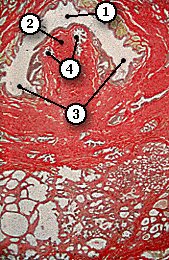SUPPLEMENTARY: 2
Prostatic Urethra (LP)
|

The prostate is a large gland which surrounds the first part of the urethra as it leaves the neck of the bladder. The prostate is surrounded by a dense capsule from which septa extend into the tissue to form ill defined lobules of glandular tissue. The glands are surrounded by smooth muscle fibres which contract powerfully at orgasm as a result of sympathetic stimulation, forcing stored prostatic secretions into the urethra. The prostatic secretion mixes with the fluid from the seminal vesicles and bulbo-urethral glands to form seminal fluid which suspends the sperm at ejaculation.
The prostate is clinically important because it undergoes benign hypertrophy from about 45 years of age and prostatic tumours are the second most common cancer and the third leading cause of cancer related death in men.

The prostatic urethra is crescentic in section (1). The ridge in posterior wall of urethra is the urethral crest (2). Passing backwards on either side of the urethral crest are the urethral sinuses (3).
The prostatic urethra is lined by transitional epithelium which stains pale yellow in this section and shows complex folds.
Lying in the substance of the urethral crest (2) are two small ducts cut in transverse section. These are the ejaculatory ducts (4) which are the terminal portions of the vasa deferentia. They pass forwards, through the substance of the prostate, from the posterior aspect of the bladder to open into the prostatic urethra on the urethral crest.
Tutorial Navigator:

